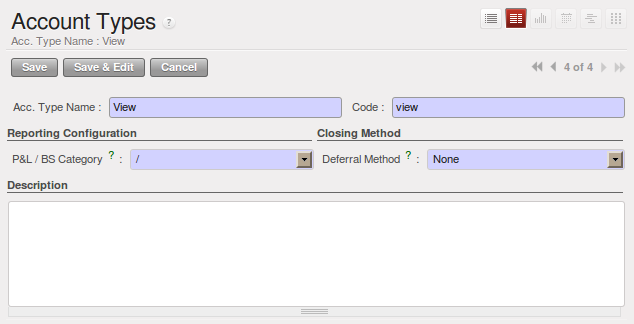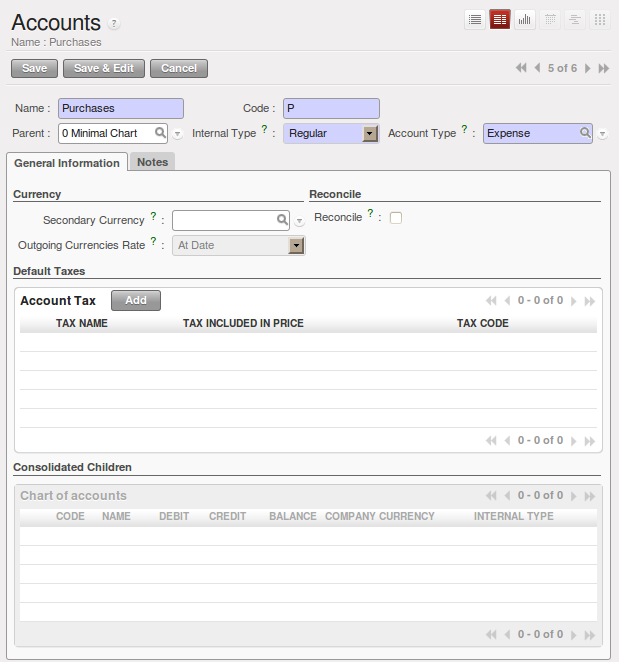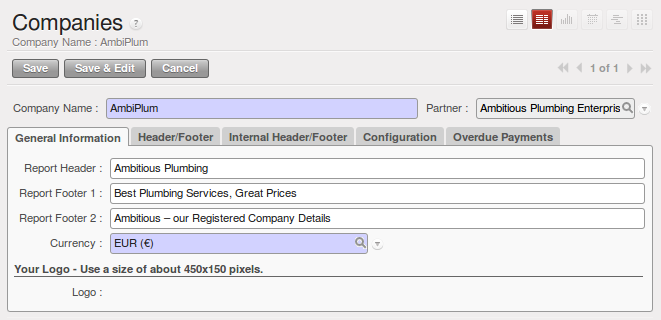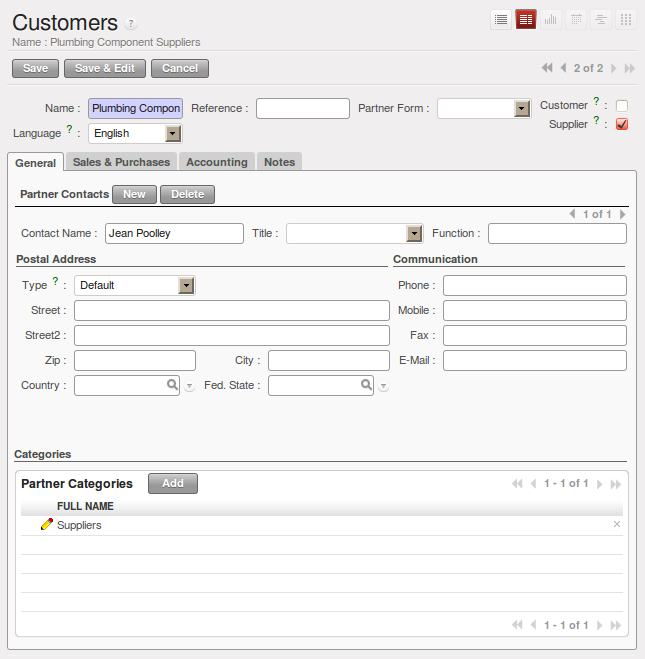帐套配置¶
You will create all the elements in the database that you need to carry out the use case. These are specified in the functional requirements.
配置会计科目¶
You need to start off with a minimal set of accounts, and to do that you will need a couple of account types. You can structure your accounts into a chart at any time (and, in fact, you can structure them into several additional charts at the same time as you will see in the chapter 一步一步配置会计), so you do not need to be concerned unduly about structure.
科目类型¶
Create account types using and then clicking the New button. You will need the following four types, the first of which is shown in figure New Account Type.
| 科目类型 | 类型CODE | P&L / BS Category | Deferral Method |
|---|---|---|---|
| View | view | / | None |
| Income | income | Profit & Loss (Income Accounts) | Unreconciled |
| Expense | expense | Profit & Loss (Expense Accounts) | Unreconciled |
| Cash | cash | Balance Sheet (Assets Accounts) | Balance |
科目¶
新建科目 and then clicking the New button.
You need accounts to handle the purchase and sales orders that have not yet been paid, two more for the receipt and shipping of goods, and one for the payment and receipt of funds. And one ‘organizing’ account that is just a view of the other five. So you will need the following six accounts, one of which is shown in New Account.
| Name | Code | Internal Type | Parent | Account Type | Reconcile |
|---|---|---|---|---|---|
| Minimal Chart | 0 | View | View | unchecked | |
| Payable | AP | Payable | 0 Minimal Chart | Expense | checked |
| Receivable | AR | Receivable | 0 Minimal Chart | Income | checked |
| Cash | C | Liquidity | 0 Minimal Chart | Cash | unchecked |
| Purchases | P | Regular | 0 Minimal Chart | Expense | unchecked |
| Sales | S | Regular | 0 Minimal Chart | Income | unchecked |
The Account Type entry is taken from the list of types that you just created.
Although it looks a bit like a text box, it does not behave in quite the same way.
A single Del or Backspace keystroke is all you need to delete the whole text,
and when you type the name (or part of the name), you still need to associate that text
with the entry by clicking the Search icon to the right of the field.
属性¶
You now define some default properties, so that you do not have to think about which account is used for which transaction every time you do something. The main new properties are the four that associate accounts payable and receivable to partners, and expenses and income to product categories.
Create properties using and then clicking the New button.
You may have switch to Extended view to be able to access this menu.
| Name | Field | Type | Value |
|---|---|---|---|
| property_account_payable | Account Payable | Many2One | (account.account) AP Payable |
| property_account_receivable | Account Receivable | Many2One | (account.account) AR Receivable |
| property_account_expense_categ | Expense Account | Many2One | (account.account) P Purchases |
| property_account_income_categ | Income Account | Many2One | (account.account) S Sales |
Tip
Mistakes in configuring accounts and properties
It is easy to make mistakes in configuring accounts and their properties, but the consequences are not immediately obvious. You will mostly discover mistakes when trying to make a Purchase or Sale Order (see later, for example, 采购), where the accounts are required fields or, if you are diligent, when you set up Partners.
If you configure them correctly at this stage, then fields will be completed automatically and you will never know a thing. If you do not configure all this correctly, then you will not be able to save the order form until you have corrected the problem or until you manually set the accounts.
Since this configuration is quite tedious, you would do best by finding a certified Chart of Accounts that has already been set up to meet your needs, if you can find one.
配置账簿¶
You will also need to configure some journals, which are used to record the transactions from one account to another when invoices are raised and then paid. Create journals from the menu and then click the New button.
| Journal Name | Code | Type | Display Mode | Entry Sequence | Default Debit Account | Default Credit Account |
|---|---|---|---|---|---|---|
| Purchase Journal | PUJ | Purchase | Sale/Purchase Journal View | Purchase Journal | P Purchases | P Purchases |
| Sale Journal | SAJ | Sale | Sale/Purchase Journal View | Sale Journal | S Sales | S Sales |
| Bank Journal | BNK | Cash | Cash Journal View | Account Journal | C Cash | C Cash |
Tip
Mistakes in configuring journals
It is easy to make mistakes in configuring the journals, too, and the consequences are also not immediately obvious. You will mostly discover mistakes when creating an invoice (which happens at different points in the process, depending on your configuration). In this example, validating a Purchase Order creates a draft invoice (see later, again for example, 采购), where a journal is required.
As with accounts and properties, if you configure them correctly at this stage, then the fields will be completed automatically and you will never know a thing. If you do not configure all this correctly, then there will be errors with the order form or corresponding draft invoice, until you have corrected the problem or until you manually set the journal.
配置公司信息¶
In case you had chosen to Skip Configuration Wizards when you first created the database, you may configure your company information in the following manner.
Start configuring your database by renaming the Main Company from its default of OpenERP S.A. to the name of your own company or (in this case) another example company. When you
print standard documents such as quotations, orders and invoices you will find this configuration
information used in the document headers and footers.
To do this, click and click the name of the only company
there, which is OpenERP S.A. . This gives you a read-only form view of the company, so
make it editable by clicking the Edit button to the upper left of the form.
Tip
Editable form in the web interface
When toggling from the list view to the form view of an item, you can generally click its name in the list view to show a non-editable view, or the pencil icon by the left-hand edge of the line to open it in an editable view. You can toggle between editable and non-editable once you are in form view.
Change the following:
- Name :
Ambitious Plumbing Enterprises, - Contact Name :
George Turnbull.
Before you save this, look at the partner’s accounting setup by clicking the tab Accounting. The fields Account Receivable and Account Payable have account values in them that were taken from the account properties you just created. You do not have to accept those values: you can enter any suitable account you like at this stage, although OpenERP constrains the selection to ones that make accounting sense.
Back at the first tab, General, change any other fields you like, such as the address and phone numbers, then Save. This changes one Contact for the Partner, which is sufficient for the example.
From the MAIN MENU, click and edit the only entry there:
- Company Name :
AmbiPlum, - Partner : should already show
Ambitious Plumbing Enterprises, - Report Header :
Ambitious Plumbing, - Report Footer 1 :
Best Plumbing Services, Great Prices, - Report Footer 2 :
Ambitious – our Registered Company Details.
Figure Changing company details shows the effect of this. You can also change various other company-wide parameters for reports and scheduling in the other tabs, and you can upload a company logo of a specific size for the reports. Click Save to store this.
You can leave the currency at its default setting of EUR for this example. Or you can
change it in this Company and the two default Pricelists () if you feel compelled to do that.
Note
Currency
The examples in this book are in USD and EUR. You, the reader, could use your home currency (perhaps CAD, CNY, GBP, or Rs) in their place.
新建业务伙伴,伙伴分类及伙伴联系人¶
You will now create a suppliers category and a customers category. Partner categories are useful for organizing groups of partners but have no special behavior that affects partners, so you can assign them as you like. Then you will define one supplier and one customer, with a contact for each.
To do this, use the menu and click New to open a new form for defining Partner Categories. Define the two categories that follow by just entering their Category Name and saving them:
Suppliers,Customers.
Then create two partners from the menu . Click on the New button to open a blank form and then add the following data for the first partner first:
- Name :
Plumbing Component Suppliers, - Customer checkbox :
unchecked, - Supplier checkbox :
checked, - Contact Name :
Jean Poolley, - Address Type :
Default, - add
Suppliersto the Partner Categories field by selecting it from the Search Partner Categories list, - then save the partner by clicking the Save button.
Figure New Partner Form shows the result.
Note
Contact Types
If you have recorded several contacts for the same partner you can specify which contact is used for various documents by specifying the Address Type.
For example the delivery address can differ from the invoice address for a partner. If the Address Types are correctly assigned, then OpenERP can automatically select the appropriate address during the creation of the document – an invoice is addressed to the contact that has been assigned the Address Type of Invoice, otherwise to the Default address.
For the second partner, proceed just as you did for the first, with the following data:
- Name :
Smith and Offspring, - Customer checkbox :
checked, - Supplier checkbox :
unchecked, - Contact Name :
Stephen Smith, - Address Type :
Default, - add
Customersin the Categories field, - Save the form.
To check your work, you can go to the menu and click on each category in turn to see the companies in the category.
Note
Multiple Partner Categories
If this partner was also a supplier, then you would add Suppliers to the categories as well, but there is
no need to do so in this example. You can assign a partner to multiple categories at all levels of
the hierarchy.
新建商品信息及其分类¶
Unlike partner categories and their assigned partners, product categories do have an effect on the products assigned to them – and a product may belong to only one category. Under the main menu link or , select the menu and click New to get an empty form for defining a product category.
Enter Radiators in the Name field. You will see that other fields, specifically those
in the Accounting Properties section, have been automatically filled in with values of
accounts and journals. These are the values that will affect products – equivalent fields in a
product will take on these values if they, too, are blank when their form is saved.
Click Save.
Note
Property Fields
Properties have a rather unusual behavior. They are defined by parameters in the menus in , and they update fields only when a form is saved, and only when the fields are empty at the time the form is saved. You can manually override any of these properties as you need.
Property fields are used all over the OpenERP system and particularly extensively in a multi- company environment. There, property fields in a partner form can be populated with different values depending on the user’s company.
For example, the payment conditions for a partner could differ depending on the company from which it is addressed.
Note
UOM
UOM is an abbreviation for Unit of Measure. OpenERP manages multiple units of measure for each product: you can buy in tons and sell in kgs, for example. The conversion between each category is made automatically (so long as you have set up the conversion rate in the product form first).
Tip
Managing Double Units of Measure
The whole management of stock can be carried out with double units of measure (UOM and UOS – for Unit of Sale). For example, an agro-food company can stock and sell ham by piece, but buy and value it by weight. There is no direct relationship between these two units, so a weighing operation has to be done.
This functionality is crucial in the agro-food industry, and can be equally important in fabrication, chemicals and many other industries.
Now create a new product through the or menu:
- Go to and click New.
- Create a product – type
Titanium Alloy Radiatorin the Name field. - Click the Search icon to the right of the Category field to select the Radiators category.
- The Product Type field should be assigned as
Stockable Product. The fields Procurement Method, Supply method, Default Unit Of Measure, and Purchase Unit Of Measure should also stay at their default values. - Enter
57.50into the Cost Price field and132.50into the Sale Price field.
- Click the Accounting tab, then click Save and observe that Accounting Properties here remain empty. When product transactions occur, the Income and Expense accounts that you have just defined in the Product Category are used by the Product unless an account is specified here, directly in the product, to override that.
- Once the product is saved, it changes to a non-editable state. If you had entered data incorrectly or left a required field blank, an error message would pop-up, the form would have stayed editable and you would need to click from tab to tab to find a field colored red that would have to be correctly filled in.
配置库位信息¶
Click to see the hierarchy of stock locations. These locations have been defined by the minimal default data loaded when the database was created. You will use this default structure in this example.
OpenERP has three predefined top-level location types , Physical Locations and Partner Locations
that act as their names suggest, and Virtual Locations that are used by OpenERP for its own purposes.
- From the Main Menu click on to reach a list view of the locations (not the tree view).
- Click on the name of a location, such as
Physical Locations/OpenERP S.A.to open a descriptive form view. Each location has a Location Type and a Parent Location that defines the hierarchical structure. While you are here you should change the location’s name toAmbitious Plumbing Enterprises, since it was named before you changed the company name. - From the click to view a list of warehouses. There is only the one at the moment, which
should also be renamed from
OpenERP S.A.toAmbitious Plumbing Enterprises.
A Warehouse contains an input location, a stock location and an output location for sold products. You can associate a warehouse with a partner to give the warehouse an address. That does not have to be your own company (although it can be); you can easily specify another partner who may be holding stock on your behalf.
Note
Location Structure
Each warehouse is composed of three locations Location Input, Location Output, and Location Stock. Your available stock is given by the contents of the Location Stock and its child locations.
So the Location Input can be placed as a child of the Location Stock, which means that when Location Stock is interrogated for product quantities, it also takes account of the contents of the Location Input. Location Input could be used as a goods-in QC location. The Location Output must never be placed as a child of Location Stock, since items in Location Output, which can be considered to be packed ready for customer shipment, should not be thought of as available for sale elsewhere.
设置会计科目表¶
You can set up a chart of accounts during the creation of a database, but for this exercise you will start with the minimal chart that you created (just a handful of required accounts without hierarchy, tax or subtotals).
A number of account charts have been predefined for OpenERP, some of which meet the needs of national authorities (the number of those created for OpenERP is growing as various contributors create and freely publish them). You can take one of those without changing it if it is suitable, or you can take anything as your starting point and design a complete chart of accounts to meet your exact needs, including accounts for inventory, asset depreciation, equity and taxation.
You can also run multiple charts of accounts in parallel – so you can put all of your transaction accounts into several charts, with different arrangements for taxation and depreciation, aggregated differently for various needs.
Before you can use any chart of accounts for anything, you need to specify a Fiscal Year. This defines the different time periods available for accounting transactions. An initial Fiscal Year was created during the database setup, so you do not need to do any more on this. You can also create a Fiscal Year manually from .
Click to open a Chart of Accounts form where you define exactly what you want to see. Click Open Charts to accept the defaults and see a hierarchical structure of the accounts.
备份数据库帐套¶
If you know the super-administrator password, make a backup of your database using the procedure
described in 管理数据库. Then restore it to a new database: testing .
This operation enables you to test the new configuration on testing so that you can be sure
everything works as designed. Then if the tests are successful, you can make a new database from openerp_ch03 , perhaps called liveor production, for your real work.
From here on, connect to this new testing database logged in as admin if you can.
If you have to make corrections, do that on openerp_ch03 and copy it to a new testing database to continue checking it.
Or you can just continue working with the openerp_ch03 database to get through this
chapter. You can recreate openerp_ch03 quite quickly if something goes wrong and you cannot
recover from it but, again, you would need to know your super-administrator password for that.




